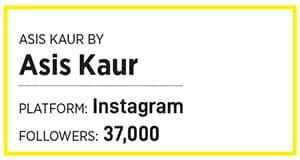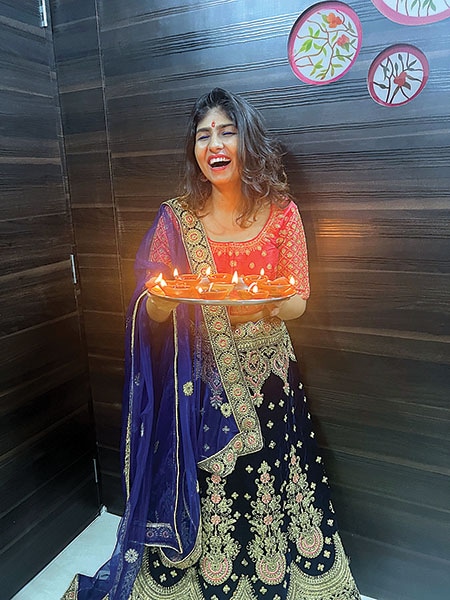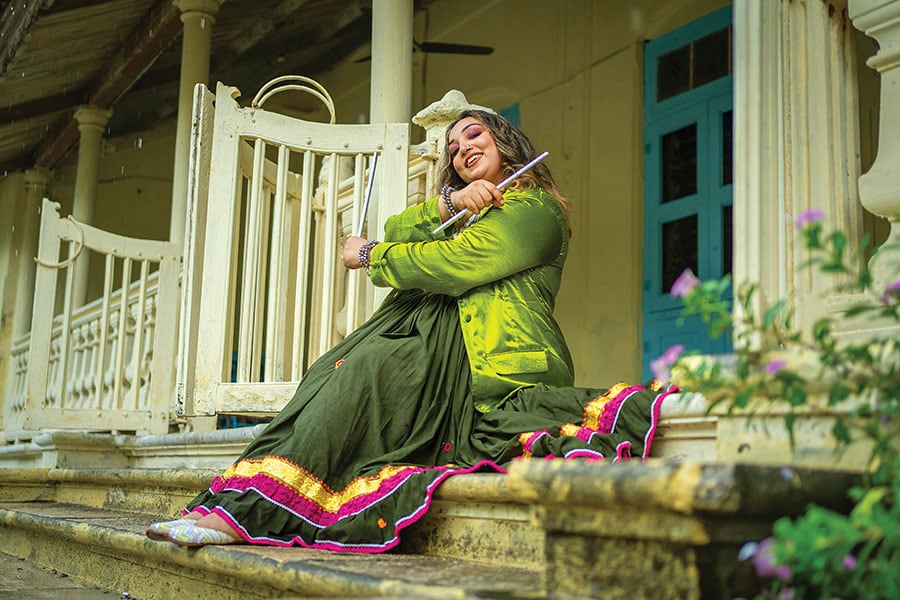According to Statista, in 2020, more than 95 percent of video consumption on Meta, Instagram, YouTube was in Indian languages. A 2021 Google-KPMG report said that Hindi, Bengali and Marathi users make up 75 percent of Indians browsing the internet.
“In the past two years particularly, there’s been huge growth in people who’re expressing themselves in regional languages on the platform," says Paras Sharma, director-content and community partnerships, Facebook India (Meta).
One big reason for this is the rise of short-form videos (SFVs). As per industry estimates, more than 200 million Indians watched SFVs at least once in 2020, with daily active users spending up to 45 minutes a day on Meta, Instagram and YouTube. By 2025, three in four internet users will consume SFVs, with some spending 55 to 60 minutes per day on them. For instance, reels (a form of SFV) has helped Instagram penetrate Tier II and III cities, where regional content creators are using the medium more than ever.
Regional creators are also expanding beyond their borders, and collaborating with creators from other geographies, says Sharma. “We also see growing interest from brands to engage with regional influencers as a way to connect with their consumers," he adds. Influencer marketing agency, One Impression, works with more than 400 brands and 55 percent of these work with, or want to discover, regional stars, says Apaksh Gupta, its founder and CEO.
YouTube has a high regional penetration, says Gupta, adding that South India certainly wins with regard to reach and engagement, since Tamil and Malayalam have a high supply and demand for regional content creator economy.
“While the South has become a big market for the creator economy, other regions are catching up," he says. “Regional content is going to be the next big thing. Audiences have a deeper connection with it. With high resonance comes high credibility, thereby affecting sales of products being sold in these markets."
Bihari banter
In a video, Chabi Gupta’s mother Anita tells her daughter, “Ee beltwa se debo na [I’ll hit you with this belt]," as she laughs hysterically. Anita is visibly shocked at Chabi’s decision to buy a Gucci belt worth ₹35,000. “It looks like a school’s belt. It shouldn’t have cost more than ₹150… ekdum bahkal bilai ho [you are a high-headed cat gone astray]," she continues.
![]() The video has garnered more than 4 million views to date, and its ‘likes’ include one from actor Priyanka Chopra. The video triggered a deluge of followers for the Instagram page YourRegularMom, created by Chabi in 2020.
The video has garnered more than 4 million views to date, and its ‘likes’ include one from actor Priyanka Chopra. The video triggered a deluge of followers for the Instagram page YourRegularMom, created by Chabi in 2020.
The Ranchi-based mother-daughter duo engage in banter in Bihari, which strikes a chord with the community. Anita reprimands her children for wasting money, and not helping with household chores, using colloquial phrases and terms such as chikanjibhi (foodie), latkhor (stubborn), khaparchatahi (silly), ek jhaap debo na (I’ll give you one tight slap) and suarni (pig).
“Your first reaction to anything would be in a native language because you always think in your mother tongue," says Anita, who is from Danapur in Patna. “I don’t pretend to be anyone else, what you see is who I am. People refer to me as mom on the streets."
For the duo, the numbers or financials that come with being content creators don’t matter at this point, although they have collaborated with brands such as Big Bazaar. Chabi says Anita is not aware of their popularity, and this is how she would like it to be. “There is recognition and fame, and I owe it to the power of Instagram and to the language that made us stand out in the crowd. The reach might be limited, but that doesn’t bother us. I’m sure one day it’ll transcend borders, and put Bihari on the global map," says Chabi.
![]() Kashmiri food blogger Omar Rather discovers unknown and forgotten foods of the region on his Instagram channel.
Kashmiri food blogger Omar Rather discovers unknown and forgotten foods of the region on his Instagram channel.
Beyond the Valley
On the Instagram page Kashmir Foodgram, you’ll see Omar Rather (28) walking on the streets of Srinagar and Jammu, talking to food vendors, showing recipes, and items most Kashmiris wouldn’t know about and anyone visiting the state must try. From the only Srinagar shop selling Tabak Maaz to showcasing local breads like katlam and krippe, the channel is a one-stop-shop for foodies.
![]() “On a trip to New Delhi, I met a food blogger who said there’s nothing beyond wazwan in Kashmiri cuisine," recounts Rather. Wazwan is a multi-course meal that is an important part of Kashmiri culture. “Since that day, I haven’t looked back, and have covered every nook and corner of the state to try and show the variety we have here. From herbs and fruits and dry fruits to vegetables, everything is unique."
“On a trip to New Delhi, I met a food blogger who said there’s nothing beyond wazwan in Kashmiri cuisine," recounts Rather. Wazwan is a multi-course meal that is an important part of Kashmiri culture. “Since that day, I haven’t looked back, and have covered every nook and corner of the state to try and show the variety we have here. From herbs and fruits and dry fruits to vegetables, everything is unique."
He started his Instagram page in 2017, and has 80,500 followers. He is aware that growth has been slow, but there are factors beyond his control. For instance, in August 2019, when the government scrapped Article 370 and divided Jammu & Kashmir into two Union Territories, it enforced a host of restrictions, including on internet connectivity.
“For one-and-a-half years, I have entered government offices, hospitals and police stations on the pretext of filling applications or to attend to emergencies, so that I can use the internet to upload a video or a post," he says. “Secondly, people are hesitant to be on camera, and get featured. Out of 100 vendors, only three will let me make a video. In Jammu, that’s not the case."
Rather is also pursuing a degree in medicine, as a back-up to a career in social media. “Par ab yeh [social media page] nasha hai mere liye [but this has now become an addiction]," he says.
![]() Independent journalist Asis Kaur talks about issues plaguing Punjab and regions around, all in Punjabi on her Instagram channel.
Independent journalist Asis Kaur talks about issues plaguing Punjab and regions around, all in Punjabi on her Instagram channel.
Passion for Punjab
In 2020, the central government appealed to farmers to call off mass protests against the three new agricultural laws, saying the protest sites could become super-spreaders for Covid-19. It did not deter the farmers nor did it stop independent journalist Asis Kaur from reporting from the field. Masked up, she walked up to policemen at the Ghazipur border, asking them why they were without masks when they should’ve been the first ones to wear them.
![]() From interviewing farmer leader Rakesh Tikait to covering the release of activists Shiv Kumar and Nodeep Kaur, and from speaking to women camped in the biting cold to following them with a camera from one border to another, Kaur used Instagram as the medium to relay news round the clock. And, it was all in Punjabi.
From interviewing farmer leader Rakesh Tikait to covering the release of activists Shiv Kumar and Nodeep Kaur, and from speaking to women camped in the biting cold to following them with a camera from one border to another, Kaur used Instagram as the medium to relay news round the clock. And, it was all in Punjabi.
Kaur, a Delhi resident, revived her personal Instagram page when Covid-19 struck. She covered news about the langar sewa organised by various gurudwaras, hospitalisations, transport, and quarantine facilities and more. And then came the farmers’ protests.
“There was a lot of fake news doing the rounds. And I wanted to post the on-ground reality, their struggles and their daily activities. From the day they reached Delhi, I was there every day," she says. “I chose to do it in Punjabi because you can convey better in your native language. And also because no one was doing it, except the Punjabi news channels." For non-Punjabi viewers, she adds English subtitles and captions. Her audience is not restricted to India, and extends to the UK, the US and Canada. “Their support helps me ignore the negativity," she adds.
Kaur is not eyeing collaborations or monetisation: “My community has given me a lot. My father taught me to walk the line of truth and speak for our community. That’s all that I am doing."
![]() Chandni Bhabhda, besides being a mimic and an actor, is bringing Marwari content to the forefront.
Chandni Bhabhda, besides being a mimic and an actor, is bringing Marwari content to the forefront.
Putting Marwari on the map
Jee raaji kar diyo, Ranbir beta, Alia no dhyaan rakhje, addhar addhar pag uthavje [You made me very happy. Ranbir, take care of Alia, and walk slow]." That’s a Marwari mother congratulating parents-to-be Alia Bhatt and Ranbir Kapoor. It’s enacted by Mumbai girl Chandni Bhabhda (22). The Marwari mimicry and voiceover artiste, actor, emcee, video jockey, dancer and lawyer started creating videos when she was 16.
![]() The video titled One Girl, Seven Voices in which she is seen mimicking actors Bhatt, Kangana Ranaut, Shraddha Kapoor, Disha Vakani and Pallavi Kulkarni has over 3.7 million views.
The video titled One Girl, Seven Voices in which she is seen mimicking actors Bhatt, Kangana Ranaut, Shraddha Kapoor, Disha Vakani and Pallavi Kulkarni has over 3.7 million views.
After graduating in law, Bhabhda tried a nine-to-five job, but didn’t like it. When she wanted to pursue content creation as a full-time profession, she was asked to get a higher law degree as a ‘back-up’. “Parents have a hard time understanding that a career in social media can be lucrative," she says. “My father is a criminal lawyer, uncle and aunt are lawyers, and we have a judge in my mother’s family."
Bhabhda even made social media content out of her journey of becoming a lawyer, showing moot court case trials, funny videos on why you should not date lawyers, types of law students, and their struggles. With time, she built more characters, and the Marwari mother and daughter-in-law came to be. “Who knew Marwari would attract so many viewers?" she says. “The thing with making regional content is that it has a high shareable value. People send me messages from Singapore, the US, and Dubai about how my videos are relatable. And I’ve only heard good things about my content in the community."
![]() Nisha Kidecha Naik is popularising Gujarati culture by showcasing the region"s arts.
Nisha Kidecha Naik is popularising Gujarati culture by showcasing the region"s arts.
G for Gujju, G for Garba
There is a famous saying about Gujaratis that says garba, a traditional dance form, is in their blood. With Covid-19 playing spoilsport, Nisha Kidecha Naik, a garba-loving Gujarati and a professional choreographer, started an Instagram page in 2020, Dancing Toes.20, at a time when people were picking up new hobbies. She started posting short and funny videos to lift people’s spirits. Naik was often seen in the kitchen, holding a rolling pin like a dandiya or breaking into a dance while mopping the floor. Each of these videos have over 5 million views.
![]() “I realised people didn’t have anything to look forward to in those bleak times. Covid-19 snatched away the most-awaited time of the year for Gujaratis," says Naik. “My aim was to spread smiles through dance and make a connection with people who loved the arts." When she started, there wasn’t much content for the diaspora, she says. “I’m a Gujarati kid, I knew content around it had to be a big part of what I do." Subsequently, she started getting compliments from Gujaratis in the US and Canada.
“I realised people didn’t have anything to look forward to in those bleak times. Covid-19 snatched away the most-awaited time of the year for Gujaratis," says Naik. “My aim was to spread smiles through dance and make a connection with people who loved the arts." When she started, there wasn’t much content for the diaspora, she says. “I’m a Gujarati kid, I knew content around it had to be a big part of what I do." Subsequently, she started getting compliments from Gujaratis in the US and Canada.
When she’s not teaching how to twirl dandiyas or do garba steps, she’s performing her own takes on Bollywood songs. Actor Alia Bhatt, whose film Gangubai Kathiawadi’s garba song ‘Dholida’ became popular, featured Naik on her Instagram story. Popular Gujarati singers such as Santvani Trivedi, Ishani Dave, Geetaben Rabari and Kairavi Buch have often promoted Naik’s work on social media. She has also been approached for collaborations.
“The response has been overwhelming. I entered this space without any expectations. There has been an outpouring of love that I was not ready for, but I always dreamt of," she says.
All data as of July 7, 2022

 The video has garnered more than 4 million views to date, and its ‘likes’ include one from actor Priyanka Chopra. The video triggered a deluge of followers for the Instagram page YourRegularMom, created by Chabi in 2020.
The video has garnered more than 4 million views to date, and its ‘likes’ include one from actor Priyanka Chopra. The video triggered a deluge of followers for the Instagram page YourRegularMom, created by Chabi in 2020.
 “On a trip to New Delhi, I met a food blogger who said there’s nothing beyond wazwan in Kashmiri cuisine," recounts Rather. Wazwan is a multi-course meal that is an important part of Kashmiri culture. “Since that day, I haven’t looked back, and have covered every nook and corner of the state to try and show the variety we have here. From herbs and fruits and dry fruits to vegetables, everything is unique."
“On a trip to New Delhi, I met a food blogger who said there’s nothing beyond wazwan in Kashmiri cuisine," recounts Rather. Wazwan is a multi-course meal that is an important part of Kashmiri culture. “Since that day, I haven’t looked back, and have covered every nook and corner of the state to try and show the variety we have here. From herbs and fruits and dry fruits to vegetables, everything is unique."
 From interviewing farmer leader Rakesh Tikait to covering the release of activists Shiv Kumar and Nodeep Kaur, and from speaking to women camped in the biting cold to following them with a camera from one border to another, Kaur used Instagram as the medium to relay news round the clock. And, it was all in Punjabi.
From interviewing farmer leader Rakesh Tikait to covering the release of activists Shiv Kumar and Nodeep Kaur, and from speaking to women camped in the biting cold to following them with a camera from one border to another, Kaur used Instagram as the medium to relay news round the clock. And, it was all in Punjabi.
 The video titled One Girl, Seven Voices in which she is seen mimicking actors Bhatt, Kangana Ranaut, Shraddha Kapoor, Disha Vakani and Pallavi Kulkarni has over 3.7 million views.
The video titled One Girl, Seven Voices in which she is seen mimicking actors Bhatt, Kangana Ranaut, Shraddha Kapoor, Disha Vakani and Pallavi Kulkarni has over 3.7 million views.
 “I realised people didn’t have anything to look forward to in those bleak times. Covid-19 snatched away the most-awaited time of the year for Gujaratis," says Naik. “My aim was to spread smiles through dance and make a connection with people who loved the arts." When she started, there wasn’t much content for the diaspora, she says. “I’m a Gujarati kid, I knew content around it had to be a big part of what I do." Subsequently, she started getting compliments from Gujaratis in the US and Canada.
“I realised people didn’t have anything to look forward to in those bleak times. Covid-19 snatched away the most-awaited time of the year for Gujaratis," says Naik. “My aim was to spread smiles through dance and make a connection with people who loved the arts." When she started, there wasn’t much content for the diaspora, she says. “I’m a Gujarati kid, I knew content around it had to be a big part of what I do." Subsequently, she started getting compliments from Gujaratis in the US and Canada.